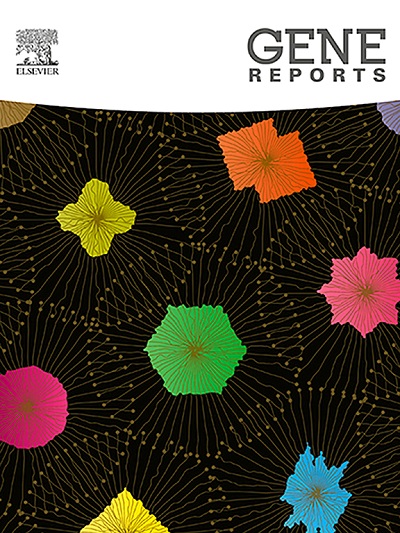社区和医院获得性尿路感染中的大肠埃希菌、肺炎克雷伯菌和奇异变形杆菌的广谱β-内酰胺酶变体
IF 1
Q4 GENETICS & HEREDITY
引用次数: 0
摘要
产广谱-β-内酰胺酶(ESBL)的肠杆菌,尤其是大肠埃希菌、肺炎克雷伯菌和奇异变形杆菌,在世界各地非常普遍。然而,关于医院获得性(HA)和社区获得性(CA)尿路感染(UTI)中肠杆菌ESBL变异株的流行情况,在发展中国家却鲜有报道。本研究分析了产ESBL肠杆菌的存在、其耐药性模式和ESBL变异体。在 279 份尿液样本中,144 份(51.6%)来自 CA-UTI 患者,135 份(48.4%)来自 HA-UTI 患者。从这些样本中,CA 组和 HA-UTI 组分别分离出 145 和 135 株肠杆菌。其中以大肠杆菌为主(202/280;72.2%),其次是肺炎双球菌(53/280;18.9%)和奇异变形杆菌(25/280;8.9%)。在 HA-UTI 分离物中,ESBL 生产者较多(131/218;60.09%)。总的来说,blaSHV(48.2%)是最主要的基因,其次是 blaTEM(44%),而在 CA 和 HA-UTI 分离物中很少检测到 blaCTX-M(7.79%)。还观察到 blaTEM 和 blaSHV 共存的现象。这项研究强调了尿路病原体中不同的 ESBL 模式,有助于更新传染病控制和抗菌药物管理指南。本文章由计算机程序翻译,如有差异,请以英文原文为准。
Extended-spectrum β-lactamase variants in Escherichia coli, Klebsiella pneumoniae and Proteus mirabilis from community- and hospital-acquired urinary tract infections
Extended-spectrum-β-lactamase (ESBL)-producing Enterobacterales, especially Escherichia coli, Klebsiella pneumoniae, and Proteus mirabilis, are highly prevalent in various parts of the world. However, the prevalence of ESBL variants in Enterobacterales from hospital-acquired (HA) and community-acquired (CA) urinary tract infections (UTI) had been infrequently reported in developing countries. This study analyzed the presence of ESBL-producing Enterobacterales, their resistance patterns, and ESBL variants. Of the 279 urine samples, 144 (51.6 %) were obtained from patients with CA-UTI and 135 (48.4 %) were obtained from patients with HA-UTI. From these samples, 145 and 135 Enterobacterales strains were isolated from the CA and HA-UTI groups, respectively. E. coli was the predominant (202/280; 72.2 %), followed by K. pneumoniae (53/280; 18.9 %) and P. mirabilis (25/280; 8.9 %). ESBL producers were higher (131/218; 60.09 %) in the HA-UTI isolates. Overall, blaSHV (48.2 %) was the predominant gene, followed by blaTEM (44 %), whereas blaCTX-M was rarely detected (7.79 %) in the CA and HA-UTI isolates. blaSHV-212, blaSHV-229, blaTEM-103, and blaTEM-104 were common among the isolates. The coexistence of blaTEM and blaSHV was also observed. This study highlights a different ESBL pattern among uropathogens that can aid in updating infectious disease control and antimicrobial stewardship guidelines.
求助全文
通过发布文献求助,成功后即可免费获取论文全文。
去求助
来源期刊

Gene Reports
Biochemistry, Genetics and Molecular Biology-Genetics
CiteScore
3.30
自引率
7.70%
发文量
246
审稿时长
49 days
期刊介绍:
Gene Reports publishes papers that focus on the regulation, expression, function and evolution of genes in all biological contexts, including all prokaryotic and eukaryotic organisms, as well as viruses. Gene Reports strives to be a very diverse journal and topics in all fields will be considered for publication. Although not limited to the following, some general topics include: DNA Organization, Replication & Evolution -Focus on genomic DNA (chromosomal organization, comparative genomics, DNA replication, DNA repair, mobile DNA, mitochondrial DNA, chloroplast DNA). Expression & Function - Focus on functional RNAs (microRNAs, tRNAs, rRNAs, mRNA splicing, alternative polyadenylation) Regulation - Focus on processes that mediate gene-read out (epigenetics, chromatin, histone code, transcription, translation, protein degradation). Cell Signaling - Focus on mechanisms that control information flow into the nucleus to control gene expression (kinase and phosphatase pathways controlled by extra-cellular ligands, Wnt, Notch, TGFbeta/BMPs, FGFs, IGFs etc.) Profiling of gene expression and genetic variation - Focus on high throughput approaches (e.g., DeepSeq, ChIP-Seq, Affymetrix microarrays, proteomics) that define gene regulatory circuitry, molecular pathways and protein/protein networks. Genetics - Focus on development in model organisms (e.g., mouse, frog, fruit fly, worm), human genetic variation, population genetics, as well as agricultural and veterinary genetics. Molecular Pathology & Regenerative Medicine - Focus on the deregulation of molecular processes in human diseases and mechanisms supporting regeneration of tissues through pluripotent or multipotent stem cells.
 求助内容:
求助内容: 应助结果提醒方式:
应助结果提醒方式:


